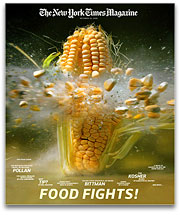Food policy hasn’t exactly been a hot-button issue in the presidential election. And it’s not going to be. We’re sure to hear more about a vague acquaintance of Barack Obama, or a bush-league politician’s fantasy-world twaddle about energy independence, than farm subsidies or school-lunch policy.

Knowing that full well, Michael Pollan has published a serious article on food policy the upcoming Sunday’s New York Times Magazine adressed not to the candidates but rather to the next president. Pollan deftly places food at the center of three key topics: climate change, energy, and healthcare. Anyone seriously interested in addressing those issues — and we can only hope the next president will be — should read his piece.
Pollan does a masterful job of framing his piece to appeal directly to the next Oval Office occupant. If that person is a thinking human being who cares about more than his own career — and not a rage-addled twit — it could actually have some influence.
Here’s his pitch in a nutshell:
[M]ost of the problems our food system faces today are because of its reliance on fossil fuels, and to the extent that our policies wring the oil out of the system and replace it with the energy of the sun, those policies will simultaneously improve the state of our health, our environment and our security.
People should plow through the whole 8,000-word piece. I want to highlight a few ideas Pollan raises that I think are particularly smart.
• He points to a proven way that the Midwest’s vast corn and soy fields could be transitioned to something much more ecologically robust and probably more lucrative for farmers. In Argentina, he writes …
… in a geography roughly comparable to that of the American farm belt, farmers have traditionally employed an ingenious eight-year rotation of perennial pasture and annual crops: after five years grazing cattle on pasture (and producing the world’s best beef), farmers can then grow three years of grain without applying any fossil-fuel fertilizer. Or, for that matter, many pesticides: the weeds that afflict pasture can’t survive the years of tillage, and the weeds of row crops don’t survive the years of grazing, making herbicides all but unnecessary.
• He calls for a rethinking of subsidies. Now, they reward gross output of a few crops, mainly corn and soy. Rather then pushing quantity, Pollan wants to push variety:
… payment levels should reflect the number of different crops farmers grow or the number of days of the year their fields are green — that is, taking advantage of photosynthesis, whether to grow food, replenish the soil or control erosion. If Midwestern farmers simply planted a cover crop after the fall harvest, they would significantly reduce their need for fertilizer, while cutting down on soil erosion. Why don’t farmers do this routinely? Because in recent years fossil-fuel-based fertility has been so much cheaper and easier to use than sun-based fertility.
• To address the question of whether a more ecological-minded, quality-oriented agri-system could "feed the world," Pollan points out that "40 percent of the world’s grain output today is fed to animals; 11 percent of the world’s corn and soybean crop is fed to cars and trucks, in the form of biofuels." Given the vast amount of farmland devoted to grain production both here and worldwide, cutting down on meat consumption and eliminating biofuel incentives would free up vast amounts of land. Why not put the weight of federal policy behind those goals?
• He also pushes an idea I raised in a speech to the Organic Summit last June in Boulder: "A program to make municipal composting of food and yard waste mandatory and then distributing the compost free to area farmers would shrink America’s garbage heap, cut the need for irrigation and fossil-fuel fertilizers in agriculture and improve the nutritional quality of the American diet." Yes!
Again, the article brims with good and provocative ideas — it needs to be read in its entirity.
If there is a weakness in Pollan’s writing, it’s his blindness to economic issues, particularly with regard to class. That’s on display here, too — although by no means fatally so. He writes, for example:
It is no small thing for an American to be able to go into a fast-food restaurant and to buy a double cheeseburger, fries and a large Coke for a price equal to less than an hour of labor at the minimum wage — indeed, in the long sweep of history, this represents a remarkable achievement.
That’s an important insight, but Pollan doesn’t tease out its implications. The ability to buy plenty of tasty calories on a low-wage salary actually lies at the heart of our economic system. For 30 years, our system has maintained corporate profits through a steady attack on wages. One of the major reasons workers have accepted stagnate wages is, I think, that food prices as a percentage of income have fallen steadily since the 1970s, a trend which went into reverse only last year. (The other is the ready availability of cheap consumer goods made by even-lower-paid workers in China).
Given that reality, it makes little sense to talk about transforming the food system and revaluing food without transforming the economic system and revaluing labor. Pollan never gets too far into those topics.
At this point, we’re watching the neoliberal era of our economic history unravel before our eyes. It’s anyone’s guess what replaces it. I do think we’ll be better off if the next president reads Pollan’s essay carefully and takes its ideas seriously.


